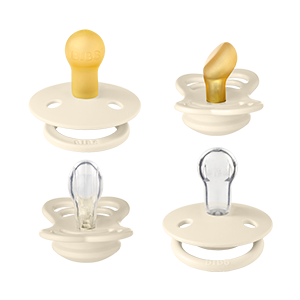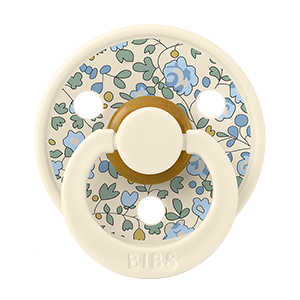
What you need to know about pacifiers and their impact on teeth
Many parents worry about the pacifier’s impact on the teeth. Don’t worry! In this blog post, we will break down the dos and don’ts, and update you on the research in the field.
Check out the video where dentist Anne Mette Stougaard explains how the use of pacifiers impacts the teeth:
Why use a pacifier?
From birth, babies have a natural sucking reflex. The baby will try to satisfy this need with the mother’s breast, a pacifier, a thumb, or another.
Many Dental Associations also support parents in the decision to introduce a pacifier. The controlled action of sucking is not only a vital reflex for the baby to get food, but it also promotes feelings of security and allows infants to self-soothe and initiate the process of self-regulation.
Read our blog post: Benefits of using a pacifier >
Different pacifiers
Conventional or round pacifier nipples are designed to resemble the shape and size of the mother's nipple and to promote a similar tongue placement and sucking technique when breastfeeding since the round shape allows the sides of the tongue to elevate and cup around the nipple, just like it does during breastfeeding.

Orthodontic pacifiers either have a flat bottom with a slightly rounded top or are flat on both sides.
These are designed so that the child does not have to suck as hard to keep it in the mouth (compared with a round nipple), which (in theory) eases the pressure on the teeth and jaw.
These pacifiers are often marketed by manufacturers as more “dental-friendly” or “orthodontic approved”, but despite claims, no studies conclusively affirm that orthodontic pacifiers definitively reduce the risk of dental malocclusion (that the teeth are not aligned properly) compared to conventional pacifiers (2-4).

Some studies exhibit that some orthodontic pacifiers induce less open bite than some conventional pacifiers (17,18). Some (19) exhibit that the difference between pacifier types regarding posterior crossbite was insignificant, and some state that evidence is insufficient to support a preference for orthodontic pacifiers preventing malocclusions when comparing orthodontic versus conventional pacifiers (2,3).
Read our blog post: Can a pacifier be orthodontic-approved >
There are many different pacifier shapes on the market. However, no studies show that specific pacifiers are better than others regarding dental malocclusion. Different pacifiers interact with the teeth and palate differently, but all pacifiers can result in so-called “pacifier teeth”.
- Dentist Anne Mette Stougaard
Pacifier impact
Studies show that prolonged use of pacifiers can result in dental malocclusion (5). This includes open bite, overbite, and crossbite. Seen in young children who use pacifiers, this is colloquially known as 'dummy teeth' or 'pacifier teeth'.
”Pacifier teeth” is a term used for teeth misalignment – also called malocclusion – that occurs after extended use of pacifiers. The continuous action of sucking on a pacifier disturbs the natural alignment of the teeth and can be seen as an open bite, overbite, or crossbite in children.
- Dentist Anne Mette Stougaard
No matter the nipple shape, all pacifiers can result in “pacifier teeth” (2). It all comes down to how intense and long your child uses the pacifier, with studies showing a relationship between hours of use per day and degree of dental malocclusion (6).
The severity of pacifier teeth primarily depends on the length and intensity of the child’s pacifier-sucking habits. The longer time and pressure the sucking habit influences the orofacial structures, the higher risk of open bite, overbite, and crossbite.
- Dentist Anne Mette Stougaard
However, multiple studies show that there is no significant association between using a pacifier and dental malocclusion on the permanent teeth - if the child stops using the pacifier before the permanent teeth erupt (7-10).
Thumb sucking vs. pacifiers
Stop in time
When a child should stop using a pacifier depends on the different dental associations. Dental associations recommend that parents gradually reduce the child's pacifier habits and stop using the pacifier altogether when the child reaches a certain age. The exact age differs slightly.
The official recommendation of the American Academy of Pediatric Dentistry (AAPD) is children stop their non-nutritive sucking habits by 3 years of age to ensure that the teeth’s position gets normalized before the permanent teeth appear (15).
Our recommendations are based on The Danish Dental Association's recommendations, which recommend stopping pacifier use by age 3 (20).
Pacifier teeth are not dangerous. The teeth usually correct themselves if pacifier use stops before age 3. At this age, the malocclusion still has time to correct itself naturally during the child’s growth.
- Dentist Anne Mette Stougaard
It is important to remember that all children are different and that it is long-term pacifier use (past age 4) that can cause alignment issues. The teeth normally get normalized if pacifier use is stopped by age 3.
Pacifier Dos & Don'ts

Q&A with Dentist Anne Mette Stougaard
Which pacifier nipple shape is best?
There are many different pacifier shapes on the market. However, no studies show that specific pacifiers are better than others regarding dental malocclusion. Different pacifiers interact with the teeth and palate differently, but all pacifiers can result in so-called “pacifier teeth”.
Is a round nipple bad for the teeth?
The round pacifier nipples are not worse than other pacifier shapes. Research shows that no matter the nipple shape, all pacifiers can result in “pacifier teeth”. It all depends on how intense and long your child uses the pacifier.
What are ”pacifier teeth”?
”Pacifier teeth” is a term used for teeth misalignment – also called malocclusion – that occurs after extended use of pacifiers. The continuous action of sucking on a pacifier disturbs the natural alignment of the teeth and can be seen as an open bite, overbite, or crossbite in children.
Are “pacifier teeth” dangerous?
Pacifier teeth are not dangerous. The teeth usually correct themselves if pacifier use stops before age 3. At this age, the malocclusion still has time to correct itself naturally during the child’s growth.
Do pacifiers affect the permanent teeth?
Long-term pacifier use – meaning using a pacifier past age 4 – can cause alignment issues with the permanent teeth. If your child stops using the pacifier by age 3, the baby teeth’ position generally gets normalized, and the permanent teeth will not be affected.
Will pacifier teeth correct themselves?
‘Pacifier teeth’ will usually correct themselves if pacifier use is stopped by age 3. At this age, the malocclusion still has time to correct itself naturally during the child’s growth.
When should you stop using a pacifier?
The recommendations about when to stop using a pacifier differ slightly depending on the dental association. My recommendations are based on the Danish Dental Association, which recommends stopping pacifier use before age 3.
Will pacifiers affect the child's speech development?
Evidence linking pacifier use to issues with speech development or speech delay is limited (11, 12). Research suggests that while prolonged day-to-day pacifier use lasting several hours may have significance with atypical speech errors, a strong speech-related justification against pacifier use is not evident (13).
What does ‘orthodontic’ mean?
The word “orthodontic” is made up of two words: “orthos” meaning “straight or correct” and “dontics” meaning “teeth”. Concerning pacifiers, the word ‘orthodontic’ refers to the thickness of the neck of the nipple. The thickness of where the nipple is attached to the shield and where the child’s teeth touch the nipple.
Can a pacifier be orthodontic-approved by dentists?
Some pacifiers are marketed as being "orthodontic approved by dentists". If this means that a dentist has approved that a pacifier does not affect the teeth, then no pacifier should be marketed as such.
Is it harmful to children’s teeth if they share their pacifiers with other children?
It is not harmful to the teeth to share a pacifier when it comes to bacteria. Today e.g., caries is considered a non-infectious disease (21), so you should not worry about your child getting infected with caries from another child or yourself. But concerning illnesses such as colds or other infectious childhood diseases, it is a good idea to keep a pacifier private and not share it.
Can children use pacifiers after a tongue- and lip-tie laser?
To clarify, a tongue tie occurs when the band of tissue that connects the tongue to the floor of the mouth is abnormally short, tight, or thick, resulting in restricted movement of the tongue. Lip-tie is a similar condition involving the band of tissue that connects the upper lip to the gum.
If the child is under 3 years old and already uses a pacifier, they can continue using a pacifier after a tongue- and lip-tie laser. But please contact your doctor for specific recommendations for your child.
About Anne Mette:
Anne Mette graduated as a dentist in 2012 from the Department of Odontology, Faculty of Health Sciences, Copenhagen, Denmark.
Anne Mette has treated children and adults as a dentist at various public and private pediatric and adult dental clinics. Furthermore, she has been a clinical teacher of dental students at the Copenhagen Dental School.
Since 2017 Anne Mette has worked with different health tech startups focusing on online and video consultations and, at present, as an independent dental consultant and speaker, primarily working on strengthening prevention, promoting dental hygiene, and spreading awareness about oral health. She’s also a mom of two little girls, who both used pacifiers.

Sources:
- Fern R Hauck 1, Olanrewaju O Omojokun, Mir S Siadaty, Do pacifiers reduce the risk of sudden infant death syndrome? A meta-analysis, 2005 Nov;116(5):e716-23. doi: 10.1542/peds.2004-2631
- Corrêa CC, Sallas Bueno MR, Pereira Lauris JB, et al. Interference of conventional and orthodontic nipples in system stomatognathic: Systematic review 2016. Codas 2016;28(2):182-9
- Medeiros R, Ximenes M, Massgnam C, et al. Malocclusion prevention through the usage of an orthodontic pacifier compared to a conventional pacifier: A systematic review. Eur Arch Paediatr Dent 2018;19(5):287-95
- Adair SM, Milano M, Dushku JC. Evaluation of the effects of orthodontic pacifiers on the primary dentitions of 24- to 59-month-old children: preliminary study. Pediatr Dent 1992; 14: 13–18.
- Manual of Pediatric Dentistry, 2022-2023/P. TBD: https://www.aapd.org/globalassets/media/policies_guidelines/p_pacifiers.pdf
- Steven M. Adair, DDS, MS Michael Milano, DMD Jennifer C. Dushku, BA, Evaluation of the effects of orthodontic pacifiers on the primary dentitions of 24- to 59-month-old children: preliminary study, s. (Pediatr Dent 14:13-18, 1992)
- Poyak J. Effects of pacifiers on early oral development. Int J Orthod Milwaukee. 2006;17(4):13-16.
- Warren JJ, Bishara SE. Duration of nutritive and nonnutritive sucking behaviors and their effects on the dental arches in the primary dentition. Am J Orthod Dentofacial Orthop 2002;121(4):347-56
- Duncan K, McNamara C, Ireland AJ. Sucking habits in childhood and effects on the primary dentition: Findings of the Avon Longitudinal Study of Pregnancy and Childhood. Int J Paediatr Dent 2008;18(3):178-88.
- Bishara SE, Watten JJ, Broffitt B, et al. Changes in the prevalence of nonnutritive sucking patterns in the first 8 years of life. Am J Orthod Dentofacial Orthop 2006;130(1):31-6
- Nelson AM. A comprehensive review of evidence and current recommendations related to pacifier usage. J Pediatr Nurs 2012;27(6):690-9
- Burr S, Harding S, Wren Y, Deave T. The relationship between feeding and non-nutritive sucking behaviours and speech sound development: A systematic review. Folia Phoniatr Logop 2021;73(2):75-88
- Strutt C, Khattab G, Willoughy J. Does the duration and frequency of dummy (pacifier) use affect the development of speech? Int J Lang Commun Disord 2021;56(3):512-27
- Thumbs, Fingers, and Pacifiers (American Academy of Pediatrics Copyright 2019)
- Fast facts: AMERICAN ACADEMY OF PEDIATRIC DENTISTRY 2014: https://www.aapd.org/assets/1/7/FastFacts.pdf
- Steven M. Adair, DDS, MS, Pacifier Use in Children: A Review of Recent Literature, Pediatric Dentistry – 25:5, 2003
- Schmid KM, Kugler R, Nalabothu P, et al. The effect of pacifier sucking on orofacial structures: A systematic literature review. Prog Orthod 2018;19(1):8.
- Caruso S, Nota A, Darvizeh A, Severino M, Gatto R, Tecco S. Poor oral habits and malocclusions after usage of orthodontic pacifiers: an observational study on 3-5 years old children. BMC Pediatr 2019;22;19(1):294.
- Zardetto CGC, Rodriguez CRMD, Stefani FM. Effects of different pacifiers on the primary dentition and oral myofunctional structures of preschool children. Pediatr Dent 2002;24(6):552-60.
- The Danish Dental Association: https://www.tandlaegeforeningen.dk/til-patienter/livsfaser/boern-og-unge/boerns-suttevaner/
- Caries - Patienthåndbogen på sundhed.dk
















